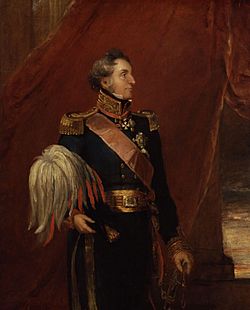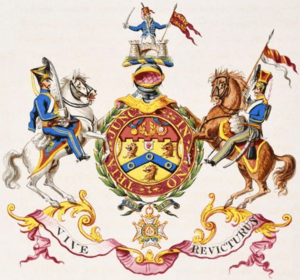Hussey Vivian, 1st Baron Vivian facts for kids
Quick facts for kids
The Lord Vivian
|
|
|---|---|

Lord Vivian
|
|
| Born | 28 July 1775 |
| Died | 20 August 1842 (aged 67) Baden-Baden |
| Allegiance | |
| Service/ |
|
| Rank | Lieutenant general |
| Commands held |
|
| Battles/wars | |
| Awards |
|
| Other work | Member of Parliament |
Richard Hussey Vivian, 1st Baron Vivian (born 28 July 1775, died 20 August 1842) was an important British military leader. He was a Lieutenant General in the army, which is a very high rank. He was also known as Sir Hussey Vivian for a time. He became a Baron, which is a type of noble title, in 1841.
Vivian was famous for leading cavalry units, which are soldiers who fight on horseback. He played a key role in several major wars, including the Peninsular War and the Battle of Waterloo.
Contents
Early Military Career
Richard Hussey Vivian was born in Truro, Cornwall. His father was John Vivian. Richard went to school at Truro Grammar School and Harrow, then studied at Exeter College, Oxford.
He joined the army in 1793. Less than a year later, he became a captain in the 28th Foot regiment. He fought in the 1794 campaign in Flanders and the Netherlands. Later, in 1798, he joined the 7th Light Dragoons, a cavalry unit. He took part in battles in Holland in 1799.
Fighting in the Peninsular War
In 1800, Vivian became a major, and by 1804, he was a lieutenant colonel leading the 7th Light Dragoons. In 1808, his regiment joined the fight in Spain during the Peninsular War. He was involved in important cavalry battles at Sahagún and Benavente.
During the difficult retreat of the British army under Sir John Moore, Vivian's 7th Dragoons often protected the rear of the army. He was also at the Battle of Corunna.
In 1813, Vivian returned to the Peninsula. He was given command of a light cavalry brigade. This unit included the 13th and 14th Light Dragoons. He fought in the Battle of the Nive in December 1813.
In 1814, Vivian led another cavalry brigade. This unit had the 18th Hussars and the 1st King's German Legion Hussars. He played a big part in the action at Gave de Pau and the Battle of Orthez. He was badly wounded in a fight at Croix d'Orade in April 1814. In this battle, his troops captured a key bridge, which helped Wellington's army against the French in Toulouse.
The Battle of Waterloo
In April 1815, Sir Hussey Vivian was given command of the 6th Cavalry Brigade. This brigade included the 10th and 18th Hussars, along with two regiments from the King's German Legion.
At the famous Battle of Waterloo, Vivian's brigade was positioned on the left side of the Duke of Wellington's army. Late in the day, his regiments were ordered to move to the center of the battle. This area was under heavy attack from Napoleon's Imperial Guard.
After the enemy was pushed back, Vivian's cavalry made the final charge of the day. They swept away French soldiers and helped secure the victory. For his bravery and service at Waterloo, he received thanks from the British Parliament and was given several awards from other countries.
After the war, Vivian stayed in France as part of the army that occupied the country.
Later Life and Political Career
After his military career, Vivian became involved in politics. He was a Member of Parliament (MP) for Truro and then Windsor from 1821 to 1831.
In 1831, he was made commander of the forces in Ireland. He also became a member of the Privy Council of Ireland, a group of advisors to the monarch.
From 1825 to 1830, he was in charge of inspecting the cavalry. He also served King William IV as a Groom of the Bedchamber from 1830 to 1837. In 1835, he became the Master-General of the Ordnance, a high military position, which he held until 1841. He was also sworn into the Privy Council of the United Kingdom that same year. From 1837 to 1841, he was an MP for East Cornwall.
In 1827, he was made a baronet, which is a hereditary title. In 1841, he was elected as a Fellow of the Royal Society, a famous scientific organization. In August of that year, he was given the noble title of Baron Vivian.
Lord Vivian passed away in 1842 in Baden-Baden. His eldest son inherited his title and his estate.
Family Life
Richard Hussey Vivian was married twice. His first marriage was in 1804 to Eliza Champion. They had several children:
- Charles Crespigny Vivian, 2nd Baron Vivian (1808–1886)
- Charlotte Eliza Vivian (1815–1877)
- John Cranch Walker Vivian (1818–1879), who became a politician.
- Jane Frances Anne Vivian (1824–1860)
- Georgina Agnes Augusta Vivian (1828–1835)
His second marriage was to Letitia Webster. They had at least one child:
- Lalage Letitia Caroline Vivian (1835–1875)
He also had a natural son, Sir Robert Vivian (1802–1887), who was raised with the family and had a successful military career in India.


